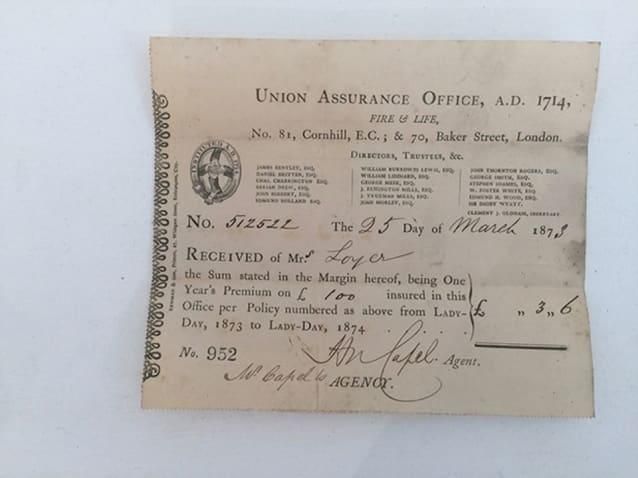Newly Discovered Papers Found in Vincent van Gogh’s London Lodging
The cache includes insurance records signed by his landlady, a volume of prayers and hymns, and watercolors possibly painted by an unrequited love interest
/https://tf-cmsv2-smithsonianmag-media.s3.amazonaws.com/filer/51/aa/51aab9a6-0f0d-49e7-b80f-ed66d03b6c11/2448.jpg)
A trove of documents recovered from Vincent van Gogh’s one-time London lodging opens a portal into the artist’s brief yet formative stay in England’s capital city.
As Martin Bailey reports for the Art Newspaper, the cache—found below the floorboards and in the attic timbers of 87 Hackford Road—includes insurance papers signed by van Gogh’s landlady Ursula Loyer, fragments of watercolor flowers perhaps painted by Ursula’s daughter Eugénie, and a well-worn volume of prayers and hymns the artist may have thumbed through during his year-long stay in the Brixton boarding house.
The Guardian’s Vanessa Thorpe writes that the newly unearthed documents speak to the significant “emotional and spiritual” change van Gogh underwent while in London: Not only did he reportedly develop unrequited feelings for Eugénie, but he also discovered a passion for theology that would later lead him to become an evangelical Christian preacher in the Borinage mining region of Belgium. (The young Vincent followed a heavily protracted career path, serving as an art dealer, teacher, bookseller and preacher before finally dedicating his life to painting.)
Van Gogh’s move to Great Britain was precipitated by his then-position as an art dealer at the London-based Goupil Gallery’s Hague branch. Reassigned to the gallery’s Covent Garden headquarters in May 1873, the 20-year-old initially roomed with three Germans but soon moved into Loyer’s guest house.
Though the property was later damaged in World War II, it was well-equipped to survive the bombings. Several months before van Gogh’s arrival, the Art Newspaper’s Bailey notes, Loyer took steps to protect her three-story home from fire; records retrieved from the house’s attic show it was valued at £100 and insured for a premium of 3 shillings and 6 pence.
After the war, the couple that purchased the home conducted repairs but left the structure's interior largely unchanged from its 19th-century appearance. This set the scene for present-day owners Jian Wang and Alice Childs' intriguing discovery: When the pair began renovations on the property—they are currently working to transform it into a base for visiting artists—they found themselves face-to-face with the long-hidden array of van Gogh-related documents.

Letters sent soon after the artist’s move to Brixton attest to his elated state of mind, Laura Freeman reports for the Times. As van Gogh fell for 19-year-old Eugénie, who ran a small school for boys alongside her mother, he told friends and family of his “absolutely beautiful” new home and mused, “Now we just have to wait and see what comes of it."
Unfortunately for van Gogh, Eugénie did not return his ardor, instead becoming engaged to a former lodger named Samuel Plowman.
“He was speaking a lot about love in his letters, sounds very happy, and then suddenly he wasn’t living at 87 Hackford Road any more, and he was absolutely despondent and beginning to think of life as a trial,” Carol Jacobi, curator of Tate Britain’s upcoming Van Gogh and Britain exhibition, tells Freeman.
The recently recovered cache of papers hints at a happier period in van Gogh’s life, according to CNN’s Michael Robinson. Although the aforementioned 1867 edition of A Penny Pocket Book of Prayers and Hymns likely belonged to the elder Loyer or her daughter, it’s possible van Gogh, as a newly devout Christian, read from it, too. Turning to the scraps of floral watercolors found underneath the floorboards of a top-floor front bedroom where the artist slept, Bailey notes that the style bears no resemblance to van Gogh’s, suggesting its creator was another individual—perhaps Eugénie.
Speaking with CNN’s Robinson, Bailey explains that while the finds are “intriguing,” none of the items can be classified as “definitely owned by van Gogh.” Still, he adds for the Art Newspaper, a rolled-up wad of papers found near the watercolor fragments is yet to be disassembled and read. It’s unlikely the documents in question belonged to van Gogh, but at the very least, they remain poised to reveal more insights on the people and places he encountered in England’s bustling capital city.
/https://tf-cmsv2-smithsonianmag-media.s3.amazonaws.com/accounts/headshot/mellon.png)
/https://tf-cmsv2-smithsonianmag-media.s3.amazonaws.com/accounts/headshot/mellon.png)